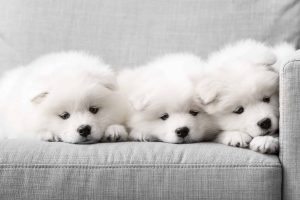Basic information about Samoyed Dogs
Samoyed dogs, often affectionately referred to as “Sammies,” are a beautiful and intelligent breed known for their fluffy white coats and friendly demeanor. Here’s an overview of Samoyed dogs:
Appearance
Samoyeds are medium to large-sized dogs with a strong and muscular build. They typically stand between 19 to 23.5 inches (48 to 60 cm) tall at the shoulder and weigh between 35 to 65 pounds (16 to 30 kg).
One of the most distinctive features of Samoyeds is their thick double coat, which consists of a soft, dense undercoat and a longer, harsh outer coat. Their coat is usually pure white, although some may have biscuit or cream-colored markings.
Samoyeds have a characteristic “Sammy smile,” which is created by the upturned corners of their mouths, giving them a perpetually cheerful expression.
They also have dark, almond-shaped eyes and erect, triangular ears.
Temperament
Samoyeds are known for their friendly, gentle, and sociable nature. They are affectionate and loyal companions who thrive on human interaction and companionship.
Despite their friendly demeanor, Samoyeds also possess a strong independent streak and may display some stubbornness, particularly during training.
Positive reinforcement methods and consistent training are essential to channel their intelligence and energy effectively.
Samoyeds are good-natured and get along well with children and other pets, making them excellent family dogs. They are often described as “gentle giants” due to their calm and patient demeanor.
History
Samoyeds are an ancient breed that originated in Siberia, where they were bred by the nomadic Samoyedic peoples for herding reindeer, pulling sleds, and guarding camps.
These dogs played a crucial role in the survival of the Samoyedic tribes, providing warmth, companionship, and assistance in their harsh Arctic environment.
In the late 19th century, Samoyeds were introduced to Europe and North America, where they gained popularity as sled dogs and companion animals. They were recognized by the American Kennel Club (AKC) in 1906.

Care
Samoyeds have high grooming needs due to their thick double coat, which requires regular brushing to prevent matting and tangling. They shed heavily twice a year, known as “blowing coat,” during which more frequent grooming is necessary.
Samoyeds are an active breed and require daily exercise to keep them mentally and physically stimulated. They enjoy activities like brisk walks, hikes, and interactive play sessions.
Due to their friendly nature and need for companionship, Samoyeds do not do well when left alone for long periods. They thrive in homes where they receive plenty of attention and interaction from their owners.
Prefered temperature
Samoyed dogs have a thick double coat that provides insulation against both cold and hot weather, making them adaptable to a range of temperatures. However, they are most comfortable in cooler climates due to their Arctic heritage. Their thick fur protects them from cold temperatures, but they may struggle in extreme heat.
The ideal temperature range for Samoyeds is moderate to cool, typically between 50 to 80 degrees Fahrenheit (10 to 27 degrees Celsius). They can tolerate colder temperatures quite well and may even enjoy playing in the snow. However, it’s essential to provide them with shelter and warmth during extreme cold weather, especially when temperatures drop below freezing.
In hot weather, Samoyeds may be more susceptible to heat-related issues due to their thick coat. It’s crucial to provide them with plenty of shade, fresh water, and access to cool areas, especially during the peak heat of the day. Avoid strenuous exercise during hot weather and keep an eye out for signs of heat exhaustion, such as excessive panting, drooling, or lethargy.

Overall, Samoyeds are beloved for their striking appearance, friendly disposition, and adaptability to various living environments. They make excellent family pets for those willing to provide them with the love, care, and attention they need.
More posts you might be interested in:

